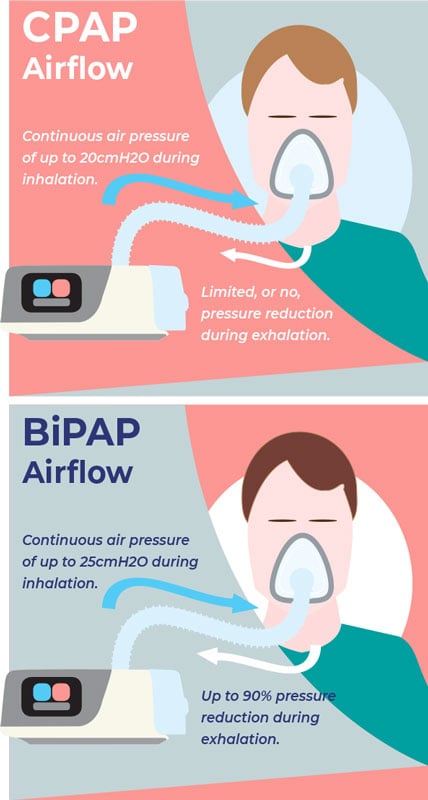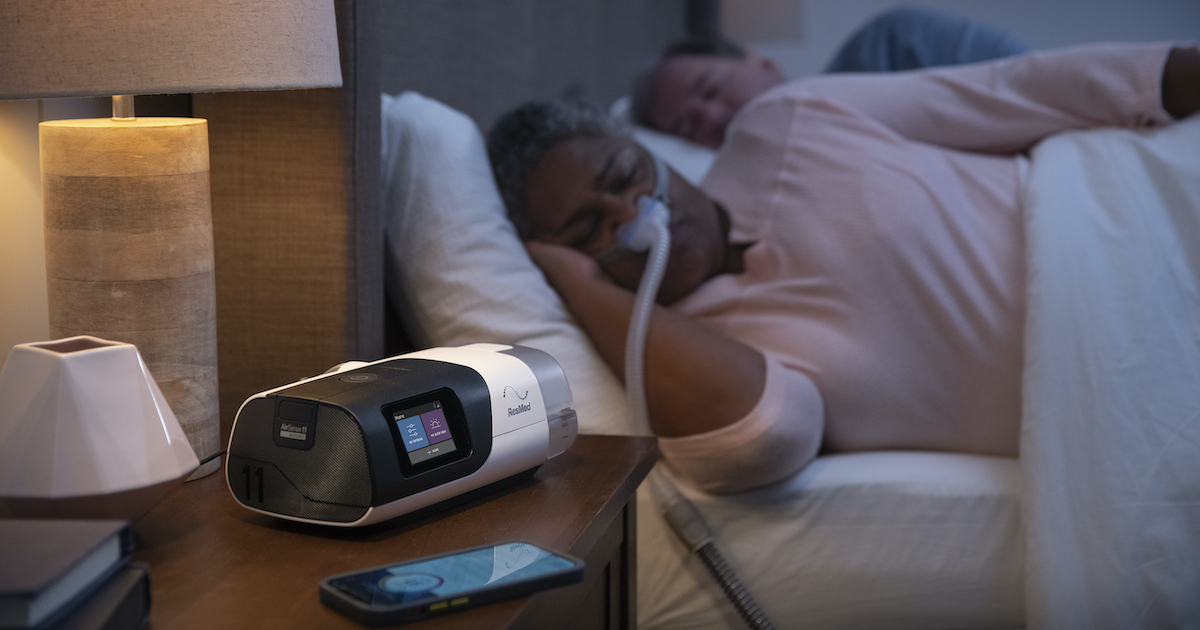Last updated on July 7th, 2023 at 11:16 am
CPAP v BiPAP: What is the difference, and what do I need?

Our customers often ask what is the difference between CPAP and BiPAP? There are a number of differences both in terms of how they work and the health conditions they are used to treat. Here is our guide to CPAP vs BiPAP, which will help you find which one will give you the best treatment.
The question really is, what do I need?
A simple answer is that this depends on your condition and the severity of your symptoms – and importantly, it is not a decision you need to make. To use either option, you will need to have taken a sleep test. The results of the test, along with any other relevant medical factors, will help your sleep expert decide whether CPAP or BiPAP is the most suitable option for your needs. If you’ve not yet taken a sleep test – you can order one online today!
So what is CPAP? Here’s what you need to know
CPAP (acronym) stands for Continuous Positive Airway Pressure.
There are two types of CPAP machines, fixed-pressure and automatic ones. A fixed-pressure machine stays at one pressure level all the time, while an automatic will determine how much pressure you need at any given time.
The “pressure” we refer to here is created by the CPAP machine blowing air into your airway, gently inflating it, which prevents it from closing or becoming blocked, preventing you from being able to breathe (an “apnoea”) during your sleep.
This pressure setting would be provided by your sleep clinic or possibly your doctor. These are calculated for your requirements based on several factors. If you have been provided with a fixed-pressure setting by your clinic or GP, then a fixed-pressure machine should do nicely. In recent years, however, automatic CPAP machines have become far more frequently used.
Automatic CPAP Machine (APAP) CPAP v BiPAP
If you do not have a specific pressure setting (most do not), then you will need to opt for an automatic machine instead, often known as APAP (wrongly, see below for a boring explanation). Automatic machines have a range of sensors built-in that allow them to calculate how much pressure you require at any given time. It can detect when you are about to stop breathing and raises the pressure (air pressure) accordingly, and once the danger has passed, it will drop down again.
This means that, on average, you will get less pressure throughout the night than you would with a fixed pressure machine, which would be set at the higher setting required. Many find the therapy to be more comfortable and more effective as a result.
So, if you have not been prescribed a fixed-pressure setting (for example, 12cmH2O), you will need an Automatic CPAP Machine. Note: Why is the term APAP technically wrong? Well, CPAP stands for “Continuous Positive Airway Pressure”. An Automatic machine still provides continuous pressure, but the level of that pressure simply changes as required – it never actually stops, so removing the “Continuous” part of CPAP is wrong. The correct name is Automatic CPAP or Auto-CPAP.
BiPAP, what is the difference? CPAP v BiPAP
A BiPAP machine does the same core job as a CPAP machine – it creates pressure in the airway by pushing additional air in through a CPAP mask and tube.
Where it differs is that a BiPAP machine can provide a much lower level of pressure when you breathe out – which makes it much easier to exhale.
That is what the “Bi” in “BiPAP machine” means – two levels of pressure. A higher one when breathing in and a lower one when breathing out. They are called IPAP (I for inhale) and EPAP (E for exhaling) pressures.
They can either change between the two settings “spontaneously” based on your breathing or on a “timed” basis – where the machine helps to regulate your breathing. Hence you will usually see BiPAP machines have “S”, “T”, or “S/T” in their name to make it clear whether they use spontaneous pressure switching, timed pressure switching, or a combination of the two. We explain this in more detail below.
Why would you need two pressure settings?
Some severe or more complicated disorders like chronic obstructive pulmonary disease or emphysema can limit lung function and make breathing out against a CPAP machine difficult. A BiPAP can significantly lower the pressure when breathing out, making it much easier and more comfortable.
In most cases, while conventional CPAP provides little to no pressure reduction while breathing out, most people are able to adjust to this and have the strength to still exhale comfortably. It can take 3-4 weeks to get used to a new CPAP device.
Central Sleep Apnoea (CSA)
Some health conditions, such as Central Sleep Apnoea, can make breathing cycles irregular, and the “timed” pressure switching provided by a BiPAP T device can help users keep their breathing regular and consistent. Otherwise, a “spontaneous” machine would usually be the better option.
The other main technical difference when comparing BiPAP vs CPAP is that BiPAP can provide more pressure than a CPAP. A BiPAP can typically provide up to 25cmH2O, while CPAP is limited to 20cmH2O. BiPAP machines can be recommended for those who require more pressure to prevent apnoeas than a normal CPAP machine can provide.
As advised above, the results of your sleep test will allow your sleep specialist to decide between CPAP v BiPAP and whether you have a medical condition which would benefit from the technical advantages that BiPAP has compared to CPAP.
Who would Benefit from BiPAP therapy?
- BiPAP machines are often prescribed to sleep apnea patients with high-pressure settings or low oxygen levels.
- BiPAPs are often used after CPAP has failed to treat individual patients adequately.
- BiPAPs can be helpful for patients with cardiopulmonary disorders such as congestive heart failure.
- Often prescribed to people with lung disorders or certain neuromuscular disorders.
CPAP V BiPAP Key Points Summary
To summarise the CPAP v BiPAP comparisons
- CPAP provides consistent pressure during both inhalation and exhalation, whereas BiPAP can have a second, much lower pressure for breathing out.
- BiPAPs can provide more pressure than a CPAP machine.
- BiPAP T machines can use a “timed” pressure switch to help regulate breathing.
- The differences mean BiPAP is typically used for patients with more complex health conditions than just “simple” Obstructive Sleep Apnoea.
- You do not need to decide which is the best option for you – your sleep specialist will determine that based on your sleep test.

